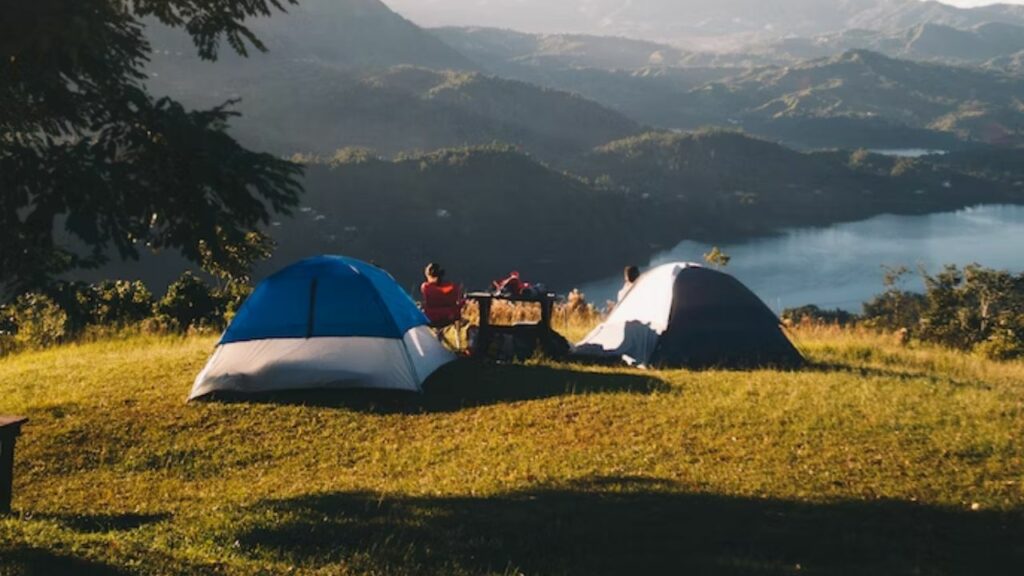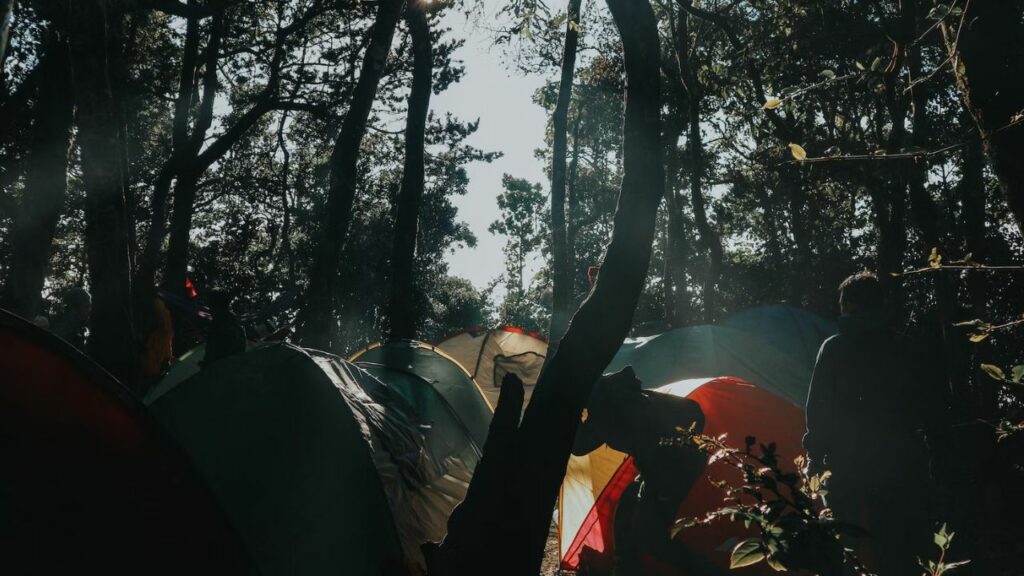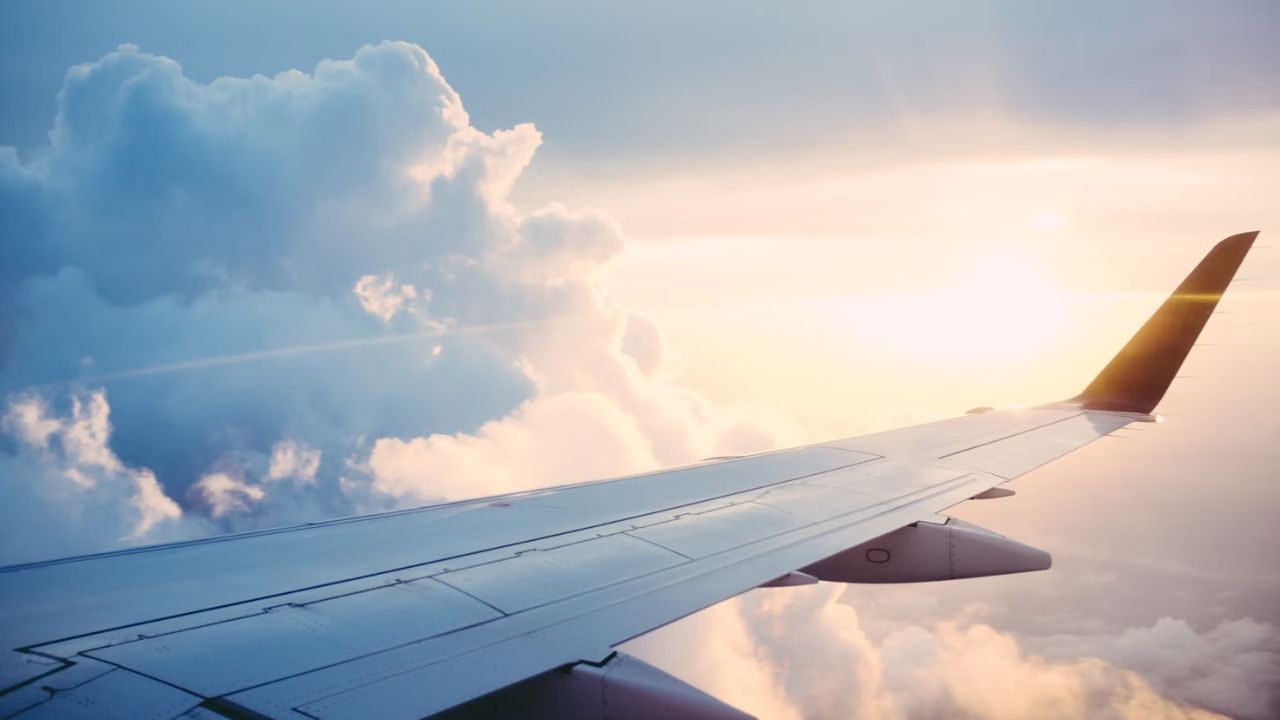Whether you’re a seasoned backpacker or a camping enthusiast, understanding the regulations and guidelines associated with air travel is crucial. After all, the last thing you want is to be caught off guard at the airport.
To set your mind at ease, I’m gonna guide you through researching specific airline guidelines and equipping you with the knowledge to make informed decisions about your camping gear.
I have been traveling for my camping and climbing trips for over a decade. And in that time, I’ve had just about every problem one could imagine with the airline officials.
Lucky for you, I have given a comprehensive breakdown here. From tents and sleeping bags to headlamps and trekking poles, you’ll know exactly what to pack and where to put them.
Let’s start with the biggest item – the giant camping backpack.
What backpacks are not allowed on planes?
Every airline has its own set of policies and regulations regarding air travel. It’s like navigating through a dense forest with hidden trails. But their guidelines about backpacks and luggage dimensions are mostly the same.
You can travel with your camping backpack in the checked luggage compartment for your next hiking trip abroad. However, your backpack must not be larger than 62 linear inches in dimension. It means the sum of your bag’s length, width, and height must not exceed 62 inches.
Conducting thorough research is the first step in preparing for your camping adventure. Take a moment to learn about the specific rules and guidelines of the airline you’ll be flying with.
Ideally, I like to contact customer service or explore their website’s hidden corners. Trust me. It’s worth the effort.
Understanding the distinctions between carry-on and checked baggage is also essential. Some airlines might allow certain camping gear in a carry-on, while others may require checking them.
What camping gear can you bring on a flight?
Let’s divide the camping gear into items suitable for checked luggage and those allowed in your carry-on.
1. Camping Gear That Must Go In Checked Luggage

Tent: Tents are typically allowed in checked baggage. Ensure it’s properly packed, possibly in a durable carrying bag or a protective case, to prevent any damage during transit.
Sleeping Bag: Cozy and essential for a good night’s rest, sleeping bags are generally permitted in checked baggage. Compression or stuff sacks can help you save space and protect your sleeping bag during travel.
Camping Stoves: Camping stoves are also allowed in checked baggage for cooking delicious campsite meals. However, clean the stove and remove any fuel sources, as they are generally prohibited due to their flammability.
Camp Cookware: Pots, pans, and cooking utensils can be packed in checked luggage. Remember to clean them thoroughly, ensuring there are no food residues that may cause issues during security screening.
Camping Utensils: Knives, forks, and spoons must also go in the checked baggage. To be safe, wrap them securely or consider using a utensil roll or travel cutlery set for organized packing.
Camp Chairs: Look for lightweight and collapsible options to save space and make transportation easier.
Other Essentials: Remember essential tools for your outdoor adventure, such as a compass, multi-tool, and first aid kit. These items are usually allowed in checked luggage but ensure any sharp objects are securely packed to avoid any issues during screening.
2. Camping Gear That Must Go In Carry-on Luggage
Headlamp/Flashlight: Ensure the batteries are installed or packed separately to comply with regulations.
Trekking Poles: These invaluable companions for hiking and stability can often be carried on board. Some airlines may require you to collapse or disassemble them for easier storage.
Additionally, some items may be subject to additional security screening or restrictions, especially if they contain batteries or other prohibited materials. Follow the Transportation Security Administration (TSA) guidelines to avoid surprises at the security checkpoint.
What camping gear can’t you bring on a flight?
While your adventurous spirit may crave their inclusion, some items are strictly prohibited from carry-on and checked baggage.

1. Prohibited Items
Flammable Fuels: Airlines prohibit flammable fuels such as gas canisters, propane tanks, and liquid fuels in carry-on and checked baggage.
Sharp Objects: Items such as axes, hatchets, and large knives with blades longer than a specified length are generally prohibited in carry-on and checked baggage. It’s important to familiarize yourself with the specific restrictions to avoid any issues during security screening.
Firearms and Weapons: Firearms, firearms parts, ammunition, and other weapons are strictly prohibited in carry-on and checked baggage. These items fall under strict regulations and should only be brought on board if authorized through the proper channels.
2. Hazardous Materials and Restrictions
Batteries: While batteries for personal electronics are generally allowed, some restrictions apply. Spare lithium batteries should be packed in carry-on baggage and not exceed certain sizes or power limits. Ensure they are properly insulated to prevent short-circuiting.
Camping Fuel Containers: As mentioned earlier, flammable fuels, including fuel containers with residues, are prohibited. Empty and clean fuel containers may be allowed in checked baggage, but it’s best to consult with your airline for specific guidelines.
3. Special Considerations for International Flights
If you’re embarking on an international camping adventure, additional considerations come into play. Customs and regulations vary from country to country, and certain items may be restricted or require permits.
Research the regulations of your destination country and consult with the appropriate authorities to ensure compliance.
Remember, these guidelines are not exhaustive, and it’s always prudent to review the policies and regulations of your specific airline and destination.
How to effectively pack and transport your camping gear?
Packing and transporting your camping gear effectively ensures a hassle-free journey and keeps your gear in optimal condition.
Here are some valuable tips to help you pack smartly and efficiently:
1. How to pack your gear for travel?
Tip 1: Make a Checklist
Create a detailed checklist of all the camping gear you must pack. This ensures you remember all essentials and helps you stay organized.
Tip 2: Utilise Packing Cubes
Invest in packing cubes or compression sacks to maximize space and keep your gear neatly organized. These handy accessories can help reduce bulk and make it easier to locate specific items.
Tip 3: Roll, Don’t Fold
Rolling your clothes and gear instead of folding them can save space and minimize wrinkles. This technique also allows for better organization and easier access to items.
Tip 4: Distribute Weight
Distribute heavy items evenly among your luggage to prevent one bag from becoming excessively heavy. This helps ensure that your bags meet the airline’s weight restrictions and makes transportation more manageable.
Tip 5: Distribute Volume
Don’t just put one thing on another; carefully analyze the dimensions of each item and pack as snugly as you can. The goal is to remove as many air pockets (wasted space) as possible. As an additional benefit, this will protect your gear from wear and tear during the flight.
2. How to protect your gear for travel?
Use Protective Cases or Bags: Consider using protective cases or bags for fragile items like cameras or other electronic gear. This provides additional layer of protection against impacts and ensures their safe arrival.
Bubble Wrap or Padding: Wrap delicate gear, such as binoculars or GPS devices, in bubble wrap or use padding to protect them from potential bumps or vibrations during transit.

Additional Considerations When Flying with Camp Gear
1. TSA Security Screening Process
Follow TSA Guidelines: Review the Transportation Security Administration (TSA) guidelines to ensure you comply with their rules and regulations. Familiarise yourself with the 3-1-1 rule for liquids, gels, and aerosols, and be aware of prohibited items.
Most importantly, allow plenty of time before your flight to navigate the security screening process smoothly. Arriving early reduces stress and gives you ample time to address unexpected issues.
2. Potential Fees for Oversized or Overweight Baggage
Understand your airline’s baggage fee structure, especially for oversized or overweight baggage. Exceeding weight or size limits can result in additional charges, so it’s important to plan accordingly or consider shipping larger items separately.
3. Travel Insurance for Valuable Camping Gear
Consider obtaining travel insurance that covers your valuable camping gear. This can provide financial protection in case of loss, damage, or theft during your journey.
How to choose the right luggage and backpack?
You have a few options when choosing the right luggage or backpack for your camping adventures.
Let’s explore them further:
1. Suitcase or Duffel Bag
If you’re not planning on backpacking and need to transport larger, bulkier items, a durable and spacious duffel bag is a fantastic choice.
Look for a duffel that can withstand rough handling, with features like reinforced corners and sturdy zippers to ensure longevity.
Consider opting for a waterproof duffel bag, especially if you’re heading to areas like the Pacific Northwest or Alaska, where rain is common. Keeping your gear dry is crucial for a comfortable camping experience.
2. Backpack
In comparison, if you’re embarking on a hiking trip, a backpack designed for camping and travel is your best bet. Look for one with adjustable straps, comfortable padding, and compartments that aid in better organization. These features ensure you can carry your gear comfortably while arranging everything neatly.
By selecting the right luggage or backpack and employing these packing tips, you’ll be well-prepared to embark on your camping adventures easily and efficiently.
How to get camping gear you can’t fly with at the destination?
Sometimes, due to airline restrictions or personal preferences, you may need help to bring certain camping gear on a flight. In such cases, there are alternative options:
Rent Gear Locally: Many outdoor destinations offer gear rental services, allowing you to access camping equipment upon arrival. Research and reserve the necessary gear in advance to ensure availability.
Purchase Gear at Destination: If you have the flexibility and budget, you can purchase camping gear at your destination. This option is particularly viable if you plan to camp frequently or travel to a region with easily accessible outdoor equipment stores.
When deciding, consider these options’ cost, availability, and convenience. Proper planning and research can help you overcome obstacles and ensure you have the necessary gear to enjoy your camping adventure fully.
Frequently Asked Questions
1. Are tents allowed as carry-on luggage?
Tents are typically too large to be carried on board as they exceed the size restrictions for carry-on bags. They are generally permitted in checked baggage.
2. How should I pack the delicate gear to prevent damage?
Wrap delicate gear in bubble wraps, such as cameras or GPS devices, or use padding to protect them from potential bumps during transit. Consider using protective cases or bags for added security.
3.: What if my camping gear exceeds the weight or size limits?
Exceeding weight or size limits the airline sets may result in additional fees. It’s important to familiarize yourself with your airline’s baggage policy and consider shipping larger items separately if necessary. It can’t exceed 120 inches in dimensions, even with the fees.
4. What if I can’t bring certain camping gear on the flight?
If you cannot bring certain camping gear on your flight, you have options. Depending on availability and your needs, you can rent gear locally at your destination or consider purchasing gear upon arrival.
5. Can you fly with a camping gas canister?
Camping gas canisters are considered flammable and are strictly prohibited on flights due to safety regulations. It’s important to dispose of any fuel sources before traveling and make arrangements to purchase them at your destination if needed.
6. Can I bring Jetboil on a plane?
Generally, you can’t bring a Jetboil on your flight. They’re portable cooking systems that typically use fuel canisters, considered flammable and not permitted on flights. The Transportation Security Administration (TSA) strictly prohibits flammable fuels and items containing them, including Jetboils in carry-on and checked baggage.

